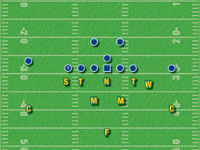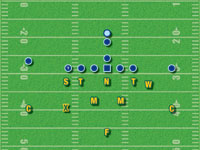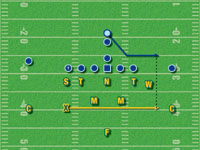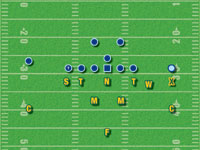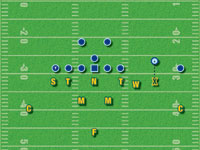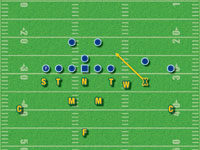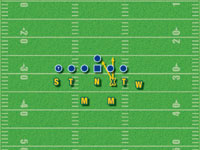AMERICAN FOOTBALL MONTHLY THE #1 RESOURCE FOR FOOTBALL COACHES
Article CategoriesAFM Magazine
|
The X FactorShutting down your opponent\'s best player.by: Brad Burton Head Coach, Otay Ranch High School, Chula Vista, CA © More from this issue Defensive football coaches, from Pop Warner to the professional level, often encounter the same challenge: stopping the single dominant player on the opponent’s offense. This may be a running back, a scrambling quarterback or a top receiver. Often the outcome of a game will be determined by shutting down this individual – the go-to guy. Using the principles of the X Factor, defensive coordinators can keep their game plan simple, yet still adjust to stopping the opponent’s main threat. The concept is very simple. Ten of the 11 defensive regulars align in a traditional 52 front (See Diagram 1).
Their assignments do not vary: they are as follows: N - Responsible for the two-gap center vs. the run; compresses the pocket vs. the pass. T - Responsible for the offensive tackle vs. the run; contains the pass rush. OLB - Responsible for force vs. run to and responsible for cutback vs. run away; responsible for curl-flat zone in pass drop. ILB - Responsible for inside-out vs. the run; responsible for hook-curl zone in pass drop. C - Responsible for containment vs. run to the safety and for pursuit vs. run away; responsible for deep zone coverage in pass drop. FS - Responsible for alley support vs. the run; responsible for three deep zone in pass drop. Player X The 11th player, identified as X, is the player responsible for making the adjustments to stop the opponent’s top player. The player is usually a strong safety-type, although he may be a nickel back, a linebacker, or possibly a defensive lineman. This player must be intelligent and a top defensive playmaker. He should be the type of player that enjoys studying game film and is likely to become a coach when his playing days are over. One common challenge is stopping a great running back. Two situations are addressed: #1: Stopping your opponent’s best running play: The X aligns toward the run tendency. For example, when the opponent is in the I formation they run to the TE side (Y) 85% of the time. X aligns accordingly, bringing an eighth defender into the box. X keys their best running back (See Diagram 2).
In this example, the X aligns toward the formation tendency. He then adjusts to motion, based upon scouted tendencies (See Diagram 3).
#2: Stopping your opponent when they have a great pass-catching running back: The X aligns toward the run tendency. The back motions out to the slot. The X adjusts and plays tight man-to-man coverage. The X knows he has zone help over the top so he can be very aggressive (See Diagram 4).
Another common challenge is stopping a talented receiver. Two situations are addressed with the X factor: Situation 1: Hitch and fade patterns by a tall and fast receiver. The X aligns in press coverage. The X plays tight man-to-man coverage. The X knows he has zone help over the top so he can be very aggressive (See Diagram 5).
Situation 2: The top receiver aligns in the slot to create a mismatch coverage vs. a linebacker. The X aligns in press coverage and plays tight man-to-man coverage. The X knows he has zone help over the top so, again, he can be very aggressive (See Diagram 6).
You can use the principles of the X factor to pressure the quarterback. Two examples are listed below: Situation 1: Pressuring from the secondary. In this situation the X aligns in press coverage. The X appears to be playing tight man-to-man coverage. On the snap, the X blitzes from the edge (See Diagram 7).
Situation 2: Taking advantage of a pass rush mismatch. The best pass rusher substitutes as X. He aligns on the opponent’s weakest pass blocker and has a free rush (See Diagram 8).
In conclusion, using the X factor has several advantages: 1. It enables the defense to take the offense’s best player out of the game. 2. It is simple for the players to learn. 3. It can be confusing for the offense. Adjustments by the X can make coverages difficult to read. 4. Using various personnel such as X can simplify short yardage and nickel packages. 5. Line slants, stunts and blitzes can easily be incorporated into the scheme. The next time you’re preparing to stop a difficult opponent, remember your secret weapon: The X Factor. |
|
| HOME |
MAGAZINE |
SUBSCRIBE | ONLINE COLUMNISTS | COACHING VIDEOS |
Copyright 2024, AmericanFootballMonthly.com
All Rights Reserved


